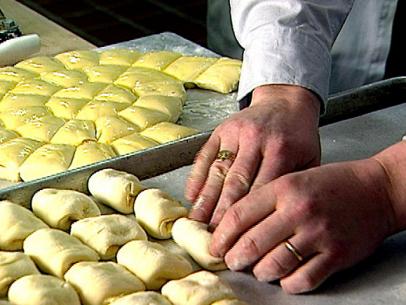
Recipe courtesy of
Emily Weinberger
for
Food Network Kitchen
Recipe courtesy of
Emily Weinberger
for
Food Network Kitchen
Watch how to make this recipe.
Hasselback Parker House Garlic Rolls
Getting reviews...
- Level: Easy
- Total: 3 hr
- Active: 1 hr
- Yield: 10 to 12 servings
-
- Nutritional Analysis
- Per Serving
- Serving Size
- 1 of 12 servings
- Calories
- 310
- Total Fat
- 19 g
- Saturated Fat
- 11 g
- Carbohydrates
- 27 g
- Dietary Fiber
- 1 g
- Sugar
- 4 g
- Protein
- 7 g
- Cholesterol
- 77 mg
- Sodium
- 205 mg
These fanciful rolls are a mashup of Parker House rolls and garlic bread that are shaped and cut to resemble Hasselback potatoes. We use a dough that combines the fluffiness of milk bread with the buttery goodness of Parker House rolls. To enhance the bread's moisture content for a soft, pillowy texture that lasts longer after baking, we use the technique known as tangzhong, where a part of the flour and liquid are cooked together first, then mixed into the whole. A flavorful garlic-Parmesan butter is spread onto the dough before rolling, and then slits cut all over each piece give the rolls the famous Hasselback effect. The rolls can be eaten separately, or the whole batch can be put out on the table and easily pulled into pieces to feed a crowd.
- Level: Easy
- Total: 3 hr
- Active: 1 hr
- Yield: 10 to 12 servings
-
- Nutritional Analysis
- Per Serving
- Serving Size
- 1 of 12 servings
- Calories
- 310
- Total Fat
- 19 g
- Saturated Fat
- 11 g
- Carbohydrates
- 27 g
- Dietary Fiber
- 1 g
- Sugar
- 4 g
- Protein
- 7 g
- Cholesterol
- 77 mg
- Sodium
- 205 mg
Ingredients
Directions
- Place 1/2 cup of the milk and 3 tablespoons of the flour in a small saucepan and whisk until no lumps remain. Place the saucepan over low heat and cook, stirring frequently, until the mixture resembles mashed potatoes, 3 to 5 minutes. Transfer the mixture to the bowl of a stand mixer and let cool while you make the dough.
- Heat the remaining 1/4 cup milk in a small saucepan over medium-high until it just starts to simmer, 2 to 3 minutes. Reduce the heat to low and stir in the sugar and 4 tablespoons butter until melted. Set aside to cool, about 5 minutes.
- Put the warm water in a small liquid measuring cup and stir in the yeast. Let it sit until foamy, about 5 minutes.
- Combine the milk mixture, yeast mixture, eggs, salt and half the remaining flour in the bowl of a stand mixer fitted with the dough hook. Mix on medium speed until smooth, about 2 minutes. Slowly add the remaining flour, mixing until well combined. Increase the speed to medium-high and continue to knead the dough until smooth and elastic but still slightly sticky, 6 to 7 minutes. Coat a large bowl with nonstick cooking spray, then place the dough inside. Cover with plastic wrap and let rise in a warm place until doubled in size, 1 hour to 1 hour 15 minutes.
- Meanwhile, in a small bowl, mix 8 tablespoons of the butter with the garlic and Parmesan and a good pinch of salt; set aside.
- Melt the remaining 4 tablespoons butter in a small saucepan over medium-low heat. Set aside.
- Spray an 8-by-8-inch baking pan with nonstick cooking spray. Line the bottom of the pan with parchment paper leaving a 2-inch hangover on 2 of the sides, then spray the paper with cooking spray.
- Lightly dust a work surface with flour. Punch down the dough, turn it out onto the prepared surface and shape into a ball. Use a chef's knife or bench scraper to divide the dough into 9 pieces and roll each piece into a ball. Working with one piece at a time, turn a dough ball upside down so the smooth side is touching your work surface. Shape the dough into a 6-by-2-inch rectangle. Dust your work surface with more flour as needed. Spread 1 heaping tablespoon of garlic butter onto the dough. Starting with one of the short ends, roll up the dough. Using a sharp paring knife, cut 7 to 8 slits widthwise on top of the dough without cutting all the way through the dough so that it looks like a Hasselback potato. Place in the prepared baking pan and repeat with the remaining dough and garlic butter.
- Brush the tops of the rolls with 2 tablespoons of the melted butter. Cover with plastic wrap and let rise in a warm place until almost doubled in size, 30 to 40 minutes. Meanwhile, preheat the oven 375 degrees F.
- Remove the plastic wrap and sprinkle the rolls lightly with flaky sea salt. Bake until puffed and golden brown, about 40 minutes. Remove from the oven and brush with the remaining 2 tablespoons melted butter. Use the parchment overhang to remove the rolls from the pan. Let rest for 20 to 30 minutes. Serve warm or at room temperature by pulling apart or slicing.
Cook’s Note
When measuring flour, we spoon it into a dry measuring cup and level off excess. (Scooping directly from the bag compacts the flour, resulting in dry baked goods.)

































